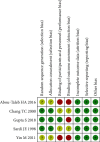Neoadjuvant Chemotherapy Followed by Radical Surgery versus Radiotherapy (with or without Chemotherapy) in Patients with Stage IB2, IIA, or IIB Cervical Cancer: A Systematic Review and Meta-Analysis
- PMID: 32802215
- PMCID: PMC7403931
- DOI: 10.1155/2020/7415056
Neoadjuvant Chemotherapy Followed by Radical Surgery versus Radiotherapy (with or without Chemotherapy) in Patients with Stage IB2, IIA, or IIB Cervical Cancer: A Systematic Review and Meta-Analysis
Abstract
Background: This study was to compare the efficacy and safety between neoadjuvant chemotherapy followed by radical surgery (NACT+RS) and radiotherapy only (RT) or concurrent chemoradiotherapy (CCRT) for treatment of patients with stage IB2, IIA, or IIB cervical cancer.
Method: The electronic databases of PubMed, Embase, and the Cochrane Library were searched to screen relevant studies from their inception to October 2018. Clinical data including overall survival (OS), disease-free survival (DFS), and adverse events were extracted. Egger's test was used to evaluate the publication bias, and sensitivity analysis was conducted to estimate the robustness of results.
Results: Finally, three randomized controlled trials (RCTs) and two case-control studies consisting of 1,275 patients with stage IB2, IIA, or IIB cervical cancer were included in the current study. Overall, pooled results showed no significant differences in OS ((hazard ratio (HR) = 0.603, 95%CI = 0.350 - 1.038) and DFS (HR = 0.678, 95%CI = 0.242 - 1.904) for patients treated with NACT+RS compared with RT only or CCRT, but the subgroup analysis showed that the OS and DFS were significantly longer in the NACT+RS groups than the RT or CCRT group (OS: HR = 0.431, 95%CI = 0.238 - 0.781, p = 0.006; DFS: HR = 0.300, 95%CI = 0.187 - 0.482, p < 0.001) for the population with median follow-up time of more than 60 months. For adverse events, the incidence of thrombocytopenia in the NACT+RS group was significantly higher than that in the RT only or CCRT group (relative risk (RR) = 3.240, 95% CI 1.575-6.662), while the incidence of diarrhea was significantly lower than that in the RT only or CCRT group (RR = 0.452, 95% CI =0.230-0.890).
Conclusion: These findings suggest that the short-term therapeutic effects of the two treatments may be possibly equal for patients with stage IB2-IIB cervical cancer, but the long-term effects for improving OS and DFS may be better using NACT+RS compared with the RT only or CCRT.
Copyright © 2020 Qingjian Ye et al.
Conflict of interest statement
No potential conflicts of interest were disclosed.
Figures
Similar articles
-
Neoadjuvant chemotherapy plus surgery versus concurrent chemoradiotherapy in stage IB2-IIB cervical cancer: A systematic review and meta-analysis.PLoS One. 2019 Nov 14;14(11):e0225264. doi: 10.1371/journal.pone.0225264. eCollection 2019. PLoS One. 2019. PMID: 31725793 Free PMC article.
-
The long-term efficacy of neoadjuvant chemotherapy followed by radical hysterectomy compared with radical surgery alone or concurrent chemoradiotherapy on locally advanced-stage cervical cancer.Int J Gynecol Cancer. 2011 Jan;21(1):92-9. doi: 10.1111/IGC.0b013e3181fe8b6e. Int J Gynecol Cancer. 2011. PMID: 21330834
-
Neoadjuvant Chemotherapy Followed by Radical Surgery versus Concurrent Chemo-Radiotherapy in the Treatment of Locally Advanced Cervical Cancer: A Multicenter Retrospective Analysis.J Invest Surg. 2022 Feb;35(2):308-314. doi: 10.1080/08941939.2020.1856239. Epub 2020 Dec 8. J Invest Surg. 2022. PMID: 33289585
-
Effectiveness comparisons of various therapies for FIGO stage IB2/IIA2 cervical cancer: a Bayesian network meta-analysis.BMC Cancer. 2021 Oct 6;21(1):1078. doi: 10.1186/s12885-021-08685-9. BMC Cancer. 2021. PMID: 34615494 Free PMC article.
-
Clinical outcome of FIGO 2018 stage IB3/IIA2 cervical cancer treated by neoadjuvant chemotherapy followed by radical surgery due to lack of radiotherapy equipment: A retrospective comparison with concurrent chemoradiotherapy.PLoS One. 2022 Mar 24;17(3):e0266001. doi: 10.1371/journal.pone.0266001. eCollection 2022. PLoS One. 2022. PMID: 35324998 Free PMC article.
Cited by
-
The contribution of the 1H-MRS lipid signal to cervical cancer prognosis: a preliminary study.Eur Radiol Exp. 2022 Oct 3;6(1):47. doi: 10.1186/s41747-022-00300-1. Eur Radiol Exp. 2022. PMID: 36184731 Free PMC article.
-
A Fifteen-Gene Classifier to Predict Neoadjuvant Chemotherapy Responses in Patients with Stage IB to IIB Squamous Cervical Cancer.Adv Sci (Weinh). 2021 Mar 18;8(10):2001978. doi: 10.1002/advs.202001978. eCollection 2021 May. Adv Sci (Weinh). 2021. PMID: 34026427 Free PMC article.
-
Neoadjuvant chemotherapy followed by surgery versus concurrent chemoradiotherapy in patients with stage IIB cervical squamous cell carcinoma: a retrospective cohort study.BMC Cancer. 2024 May 29;24(1):655. doi: 10.1186/s12885-024-12411-6. BMC Cancer. 2024. PMID: 38811880 Free PMC article.
-
Dose-Intense Cisplatin-Based Neoadjuvant Chemotherapy Increases Survival in Advanced Cervical Cancer: An Up-to-Date Meta-Analysis.Cancers (Basel). 2022 Feb 8;14(3):842. doi: 10.3390/cancers14030842. Cancers (Basel). 2022. PMID: 35159111 Free PMC article. Review.
-
Construction of an immune-related ceRNA network in cervical cancer based on HPV E6 splicing.Front Oncol. 2022 Dec 14;12:979884. doi: 10.3389/fonc.2022.979884. eCollection 2022. Front Oncol. 2022. PMID: 36591476 Free PMC article.
References
-
- WHO. World Health Organization Report: comprehensive cervical cancer control: a guide to essential practice. World Health Organization web site, 2006. February 2008, http://www.who.int/reproductive-health/publications/cervical_cancer_gep/.... - PubMed




